I present a series of steps you can use to build a power base for any deck. The steps should be easy to follow with a minimum of difficult decisions. Power bases made using this method are likely suboptimal but always functional. It is, of course, possible to further refine power bases.
Example decks are included to aid explanation. The decks are likely suboptimal, but somewhat functional, and are not the focus of this article. You can take them for your own use, at your own risk.
Contents
Step 1: Choose power count.
Step 2: Add sigils.
Step 3: Add rainbow fixing.
Step 4: Note the required dual count.
Step 5: Add duals.
Step 6: Change power types.
Step 7: Check your work.
Another Example Deck
Closing Remarks
Step 1: Choose Power Count
Build the rest of the deck, leaving the power slots empty. The proper power count ranges from 25 to 34 depending on your curve. The example deck is Screaming Tower, which only has 4 cards above 3 cost and thus plays the allowed minimum of 25 power.
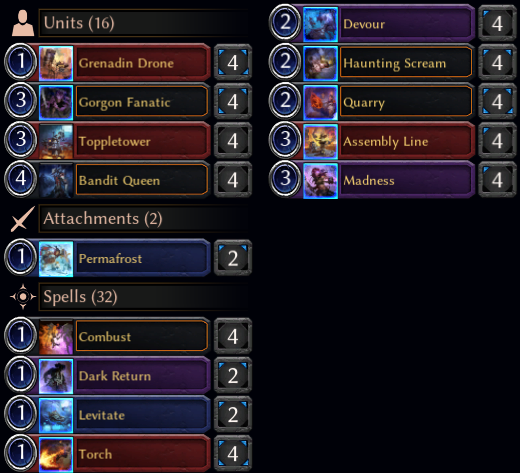
Step 2: Add Sigils
Use influence requirement reference tables or a hypergeometric calculator. To do so, you need to decide the percentage chance you want to hit each of your color requirements. If you're unsure, use 80%. Hypergeometric percentages are lower than percentages during play because you actually get two adjusted starting hands, not one random starting hand.
I examine each of the example deck's 3 colors in turn.
Bandit Queen requires FF on turn 4. This is the only FF card in the deck, so I don't need 80% to hit it. I go to the 75% table, and find that I need 18 sources.
Quarry requires S on turn 2. I debate with myself between using the 80% or 85% chart, since although it is extremely important to Quarry on time, 2 extra sources really is a lot. I end up deciding to go with 80%, 14 sources. Note that compromising and deciding on 15 sources is a perfectly acceptable solution here, too.
I really, really need Primal on turn 4 to cast all the Primal cards that help push Infiltrates through, but can function without it earlier. 85% to find 1 Primal source by turn 4 requires 13 sources.
I add 18 Fire, 14 Shadow, and 13 Primal sigils to my deck.
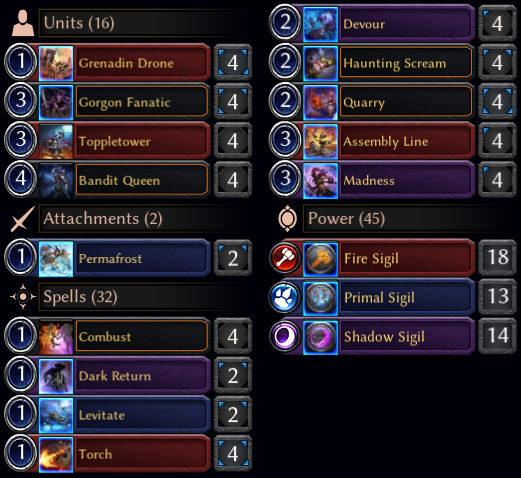
Step 3: Add Rainbow Fixing
Rainbow fixing means fixing that can become all colors of influence the deck needs. Remove a sigil of each color for each card of rainbow fixing added.
The example deck requires 4 influence total, making it a good deck for Diplomatic Seal. It has no other viable rainbow fixing option. I add 4 Diplomatic seal and remove 4 of each sigil.
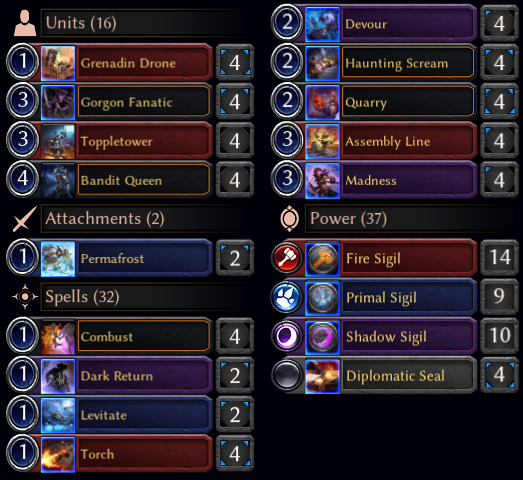
Step 4: Note The Required Dual Count
Subtract 75 from the current number of cards in your deck, and that is how many duals you will need. If this results in an unrealistically high number of duals, you must either change your deck to need less influence, change your deck to run more power, or go back to step 2 and pick less ambitious numbers. Any more than 14 duals likely means much of your power will be depleted, and any more than 16 will make your deck uncompetitively slow.
The example deck has 87 cards, meaning it needs 12 duals. This is acceptable, so I proceed to the next step.
Step 5: Add Duals
Remove 2 sigils of different colors and add a dual that is those colors. Don't worry about the type of dual yet. Repeat until your deck is 75 cards.
For the example deck, I add the 12 crests in the factions I'm playing, removing sigils as I do.
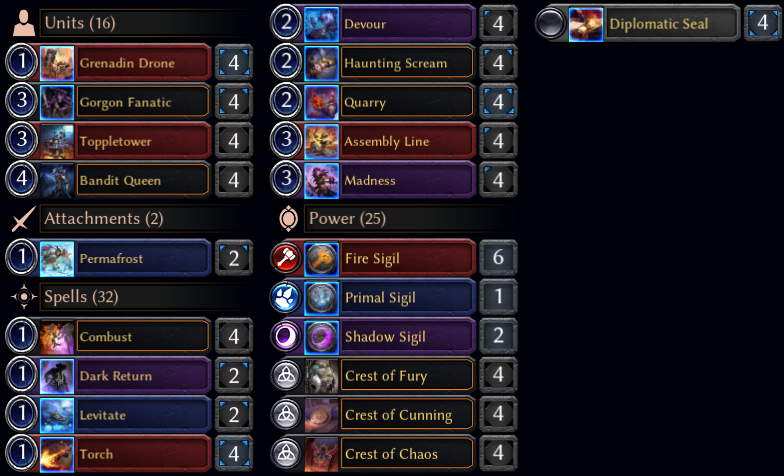
Step 6: Change Power Types
Finally, optimize the types of power cards the deck runs without changing the total influence counts. This involves a lot of guesswork and subjectivity, but also won't make your deck much worse if you do it wrong. There are two types of optimization:
Changing a source to one that produces identical influence. For example, changing a banner to a crest, or changing a sigil to a waystone.
Changing a dual to one that produces different influence and adjusting sigils at the same time. For example, changing a Praxis dual to an Elysian dual, adding 1 Fire Sigil, and removing 1 Primal Sigil.
The first type of optimization is useful to get the most benefit out of your power cards. Be careful not to make your power base too depleted in the process. The second type of optimization can enable the first type, but is also useful in its own right since in general, you want your cards to be in the same colors as your duals.
The example deck's duals are all crests, which is ok since crests are very good to have. It has no seats, so I can turn as many sigils I'm allowed into waystones so they stay undepleted with a bit of extra benefit. There are no other apparent optimizations available.

Step 7: Check Your Work
Examine the deck to make sure everything makes sense. Count the number of sources in each color to make sure they are the numbers you have chosen in the first place. You can also draw a few sample starting hands to see how the power base will perform in practice.
The example deck now has 20 Fire, 13 Primal, and 14 Shadow sources, the numbers I had intended to begin with. I drew some sample hands and most of them were playable, so I am reasonably sure that the power base is functional.
Another Example Deck
I apply my method to another deck without following each step in rigid order. This is close to what I'd do when making actual decks I use. In fact, this is exactly what I did with this deck. It is my take on 4f Mask, inspired by IlyaK1986's attempt.
I decide that my deck should have 4 Seek Power and 2 Find the Way. Since I know these will be in my deck, I add them right away.
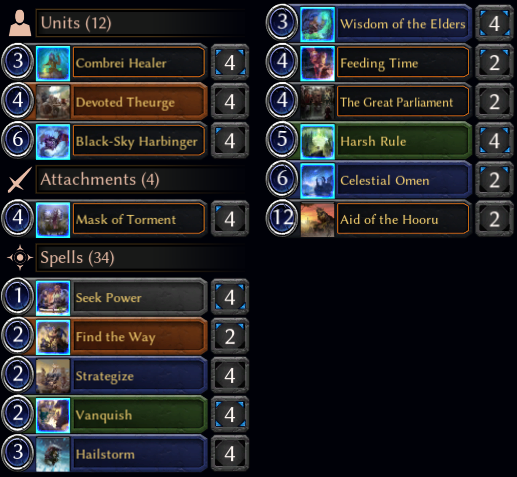
This is a slow control deck that really needs to hit all of its influence requirements at some point every game. For this reason and because I'm lazy, I didn't bother examining which influence requirements I need the most, and just went with 80% for each. I can revise the decision to use this shortcut later if I need to.
According to the charts, I need 22 Primal, 20 Time, 18 Justice, and 11 Shadow sources. Seek Power is rainbow fixing, and I count each Find the Way as 1.5 rainbow fixings, giving each color 7 sources. I add 15 Primal, 13 Time, 11 Justice, and 4 Shadow sigils.
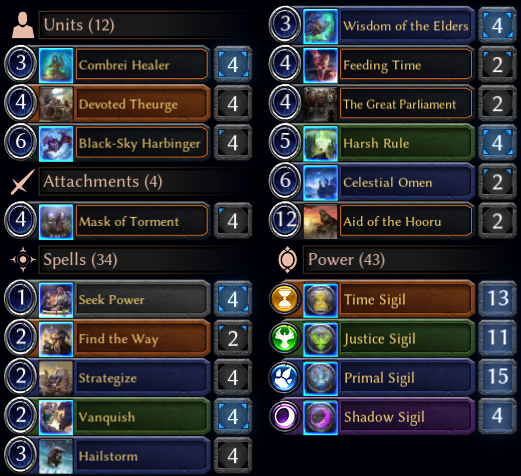
The deck is now 93 cards, meaning I'd need 18 duals. Realizing that any number of duals greater than 16 will make a deck uncompetitively slow, I roll with it anyway, because chances are this deck isn't competitive even with a faster power base.
With 4 colors, I need to approach adding duals methodically to prevent screwing up. I replace two sigils with one dual at a time, choosing the sigils I have the most of each time, and choosing the uppermost sigil in the list in case of ties. I don't care which kind of dual I am adding, since those will be adjusted later.
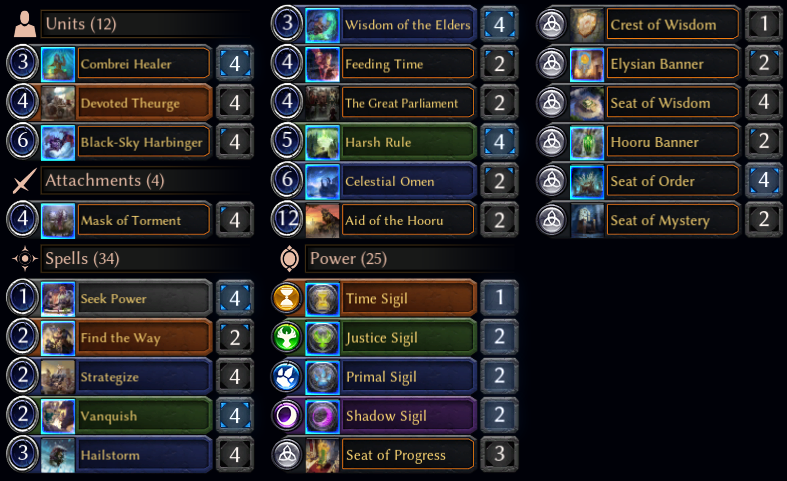
This configuration only has 1 Time Sigil when the deck requires 2 Time influence, so I might run out of Time Sigils to fetch before my Time requirement is met. To fix this problem, I need to remove a Shadow Sigil, add a Time Sigil, and change my duals to maintain my influence totals. Note that I could have avoided this problem by choosing the lowermost instead of uppermost Sigil to remove when adding my duals, but it's too late to do that now.
I add a Time Sigil, add a Justice Sigil, and remove a Seat of Progress. I remove a Justice Sigil, remove a Shadow sigil, and add a Seat of Vengeance. I maintain my influence totals while solving my problem of only having 1 Time Sigil.
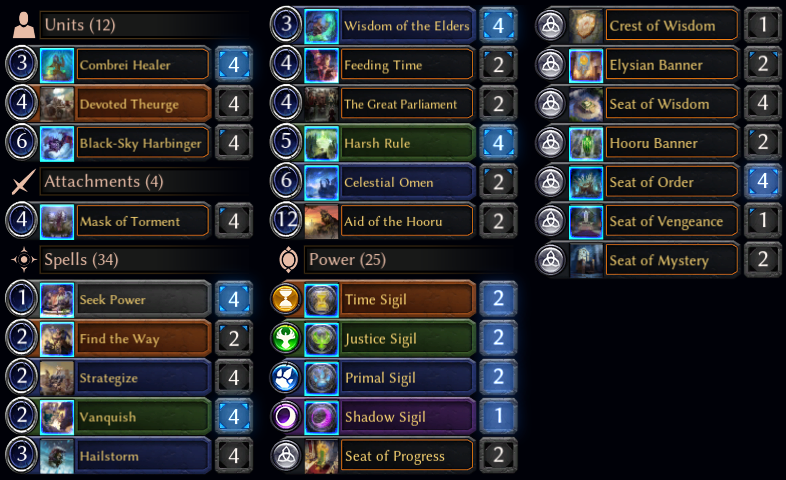
This very slow control deck currently only has 1 crest. It should have as many as it can support, since it really doesn't care about curving out and could use the extra filtering. The most obvious step now is to change as many existing duals into crests of the same factions as possible.
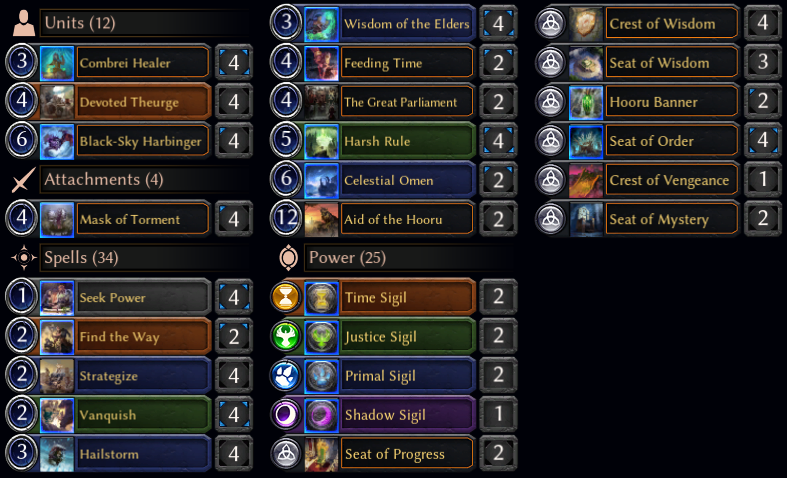
It is possible to fit more crests into this deck, even though the only available crests now are of Vengeance and Cunning and there aren't any more of those duals to replace. I do this by swapping duals around to create duals of the right color.
In particular, I remove a Seat of Mystery, add a Time Sigil, and add a Shadow Sigil. I change a Time Sigil to a Justice Sigil and change a Hooru Banner to a Seat of Wisdom. I can now remove a Justice Sigil, remove a Shadow Sigil, and add a Crest of Vengeance. I repeat the entire process to add a third Crest of Vengeance, except this time I already have 4 Seats of Wisdom and must add an Elysian Banner instead.
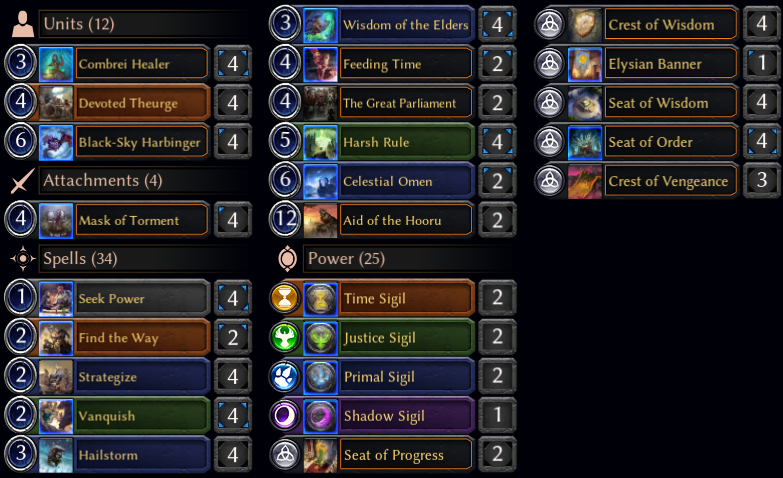
This configuration has a banner, which is not ideal since in such a heavy control deck, banners are essentially always depleted with no benefit. I would like to change it into a different type of dual, but I'm already running a full 8 other Elysian duals. I will need to shuffle my duals around to solve this problem.
I remove the Elysian Banner, add a Time Sigil, and add a Primal Sigil. I remove a Primal Sigil, remove a Shadow Sigil, and add a Crest of Cunning. I swap the extra Time Sigil for the missing Shadow Sigil, and change a Crest of Vengeance into a Seat of Progress to balance my influence totals.
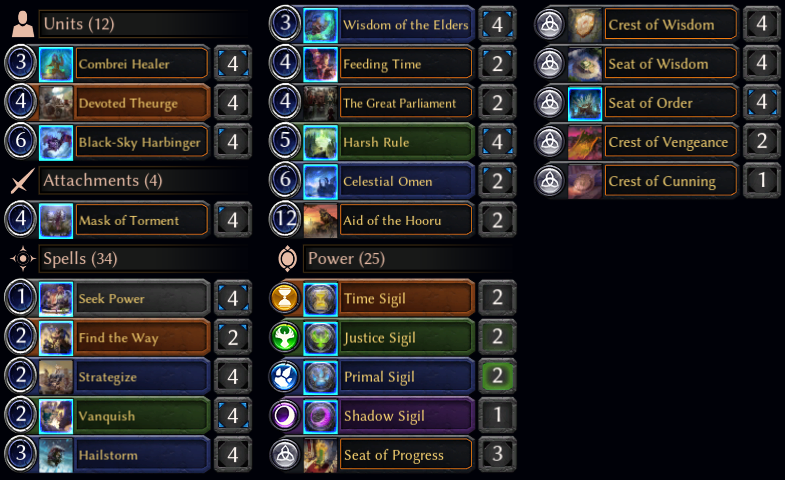
There is one final optimization possible. I have 8 Elysian duals yet no Elysian cards to cast, and 2 Argenport duals with no Argenport cards. I swap a Crest of Vengeance for a Crest of Cunning, and swap a Seat of Wisdom for a Seat of Progress. Now I only have 7 Elysian duals for my 0 Elysian cards, and 1 Argenport dual for 0 Argenport cards.
If I repeat this process, I would have to add a banner, since I already have 4 Seats of Progress and Crests of Progress do not exist. Having a banner is worse for this deck than having mismatched duals and cards, so I don't do that. The final result:
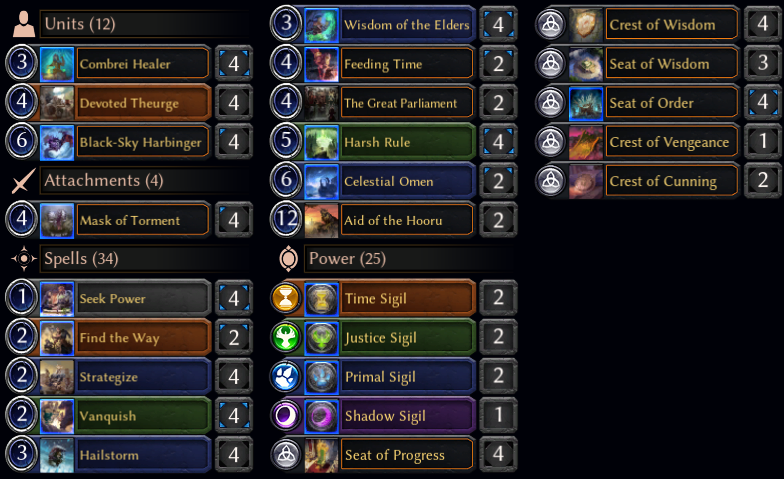
To check my work, I tally up the number of sources of each color, counting my 4 Seek Power and 2 Find the Way as 7 sources for each color. I count 20 Time, 18 Justice, 22 Primal, and 11 Shadow sources, which is what I had intended. The Sample Hand feature isn't as helpful for such a slow deck, since the majority of the cards I will see while playing it will not be opening hands. I skip that step and go straight to play testing.
In the end, the power base hits its influence requirements surprisingly consistently, considering the greediness of the deck. The multitude of seats even makes it undepleted fairly often. But 7 sigils is simply too few, and the deck suffers from too much depletion to be anywhere close to competitive, which is what I expected out of such a 4f monster.
Closing Remarks
The astute reader will notice that my method fails to take into account some crucial factors in building power bases. Notably, it completely ignores the help from cheap early cycling and scouting. It also does not take into account that counting rainbow fixing as 1 of each color is overly generous, since you often have a Seek Power that can only get one of your several missing influences.
These omissions are intentional. First, there is the issue of article length. This article is already over 3000 words, and would be even longer had I accounted for these effects. Secondly, accounting for these effects would dramatically raise the complexity of the method, which goes against my goal of making the steps "easy to follow with a minimum of difficult decisions". Thirdly, the effects of the omissions are errors in opposite directions. Ignoring cheap cycling and scouting makes the numbers generated by the method too high, and ignoring that rainbow fixing can be overloaded makes the numbers too low. In a very crude fashion, these two errors tend to cancel each other out, making the actual number closer to accurate.
I use this method myself to build the power bases for the first versions of my decks, then refine them by play testing. The end result is usually very similar to the generated power base, but not identical. I encourage you to do the same.
As for the example decks, their current power bases in the real world are remarkably close to what was presented here. I have replaced 1 Fire Sigil with a Stonescar Banner in Screaming Tower, and replaced 1 Seat of Order with a Crest of Vengeance in 4f Mask.
I do not claim to be an authority on building power bases, but I do claim to build better power bases than the majority of lists I see. Please try the method and let me know how it goes, ideally by facing me on ladder using a deck that has a nice, reasonable, functional power base.
References
The tables below show the number of power sources needed in a 75-card deck to achieve various power and influence requirements.
The effects of the redraw rule, deck thinning, and card draw are not shown.
These effects combined make the actual number of sources needed for real decks lower than these tables would suggest.
Entries with asterisks (*) indicate more sources than the turn number, such as 6 sources by turn 3. Most decks don't care for these chances, but they are included for the sake of completeness.
These tables are references, not part of the guide. They do not provide any instruction on how to build a power base. Rather, They contain information that may be useful in this process.

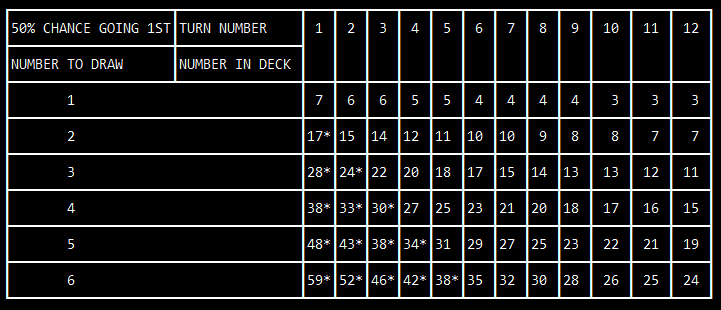
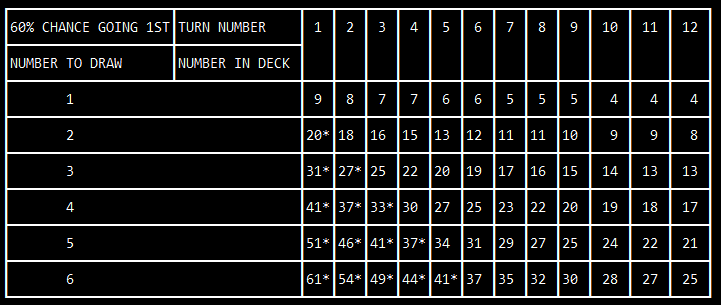
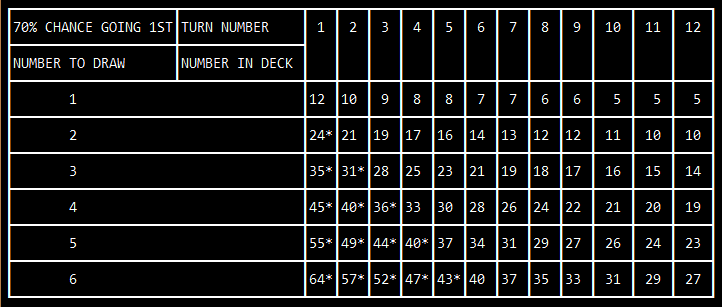
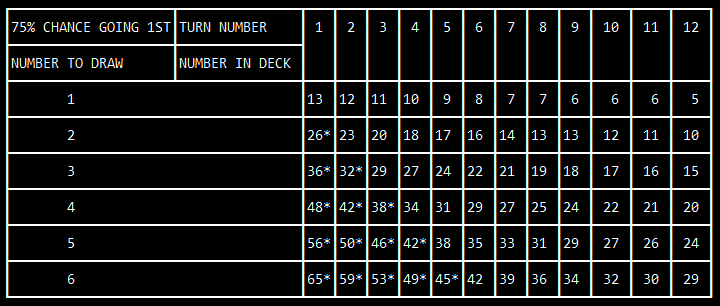
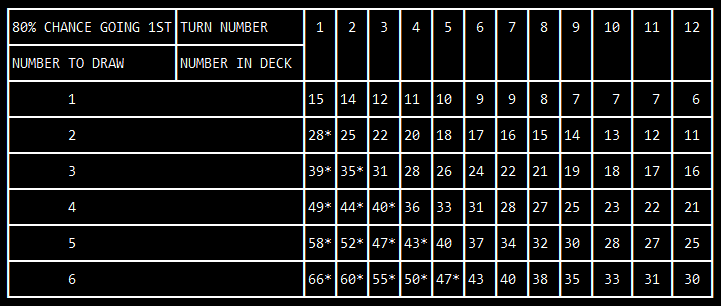
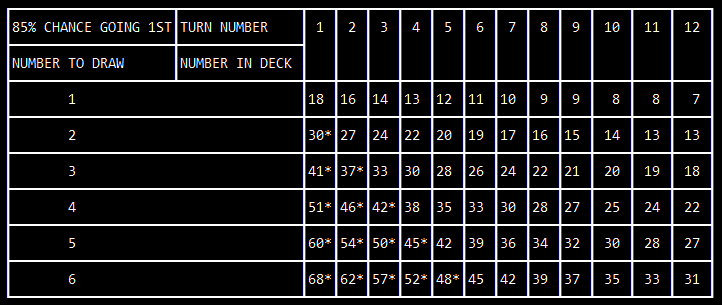
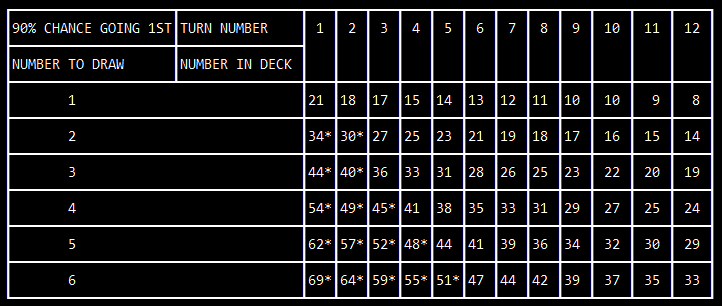
Slabgar
13 Sep 2018Your tables aren't showing up at the bottom of the article anymore.
Buckwheat
21 Jun 2018I tried stuff until it worked. Eventually I tried so much stuff that worked that I started seeing patterns in how I tried it. This is a summary of my most successful attempts.
a
22 Jun 2018Thanks man. My TJS deck works much better after using this method. Gonna look forward to your articles.
a
19 Jun 2018How did you come up with this method?